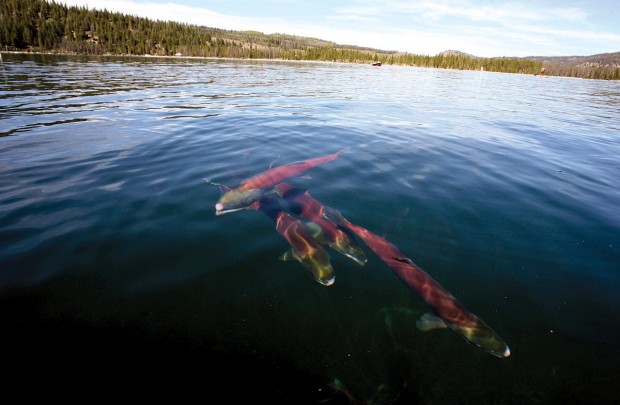forum
library
tutorial
contact

Spawning Time, When Sockeye Salmon
Change from Blue to Red
by Joanna KleinNew York Times, June 9, 2017
|
the film forum library tutorial contact |

|
Spawning Time, When Sockeye Salmon
by Joanna Klein |
 In the Bristol Bay region of Alaska, an estimated 40 million sockeye salmon are returning from the Pacific Ocean to the freshwater streams and lakes where they grew up. There, they will find mates, spawn and die. But before that, they transform. The "bluebacks" become "reds." And if you happen to be in the area, you can witness one of the most miraculous costume changes of the animal kingdom.
In the Bristol Bay region of Alaska, an estimated 40 million sockeye salmon are returning from the Pacific Ocean to the freshwater streams and lakes where they grew up. There, they will find mates, spawn and die. But before that, they transform. The "bluebacks" become "reds." And if you happen to be in the area, you can witness one of the most miraculous costume changes of the animal kingdom.
"That's one of the biggest concentrations of sockeye salmon in the world," said Chris Foote, a behavioral ecologist at Vancouver Island University. "They're in the early parts of their marine run to freshwater now, and that will peak in the next couple of weeks."
After hatching, sockeye salmon spend up to four years developing in lakes and connected streams. Then they go to sea.
In the ocean, they look like typical fish: black-speckled, blue-backed and white-bellied. But in their long-distance journeys to their spawning areas, their bodies slowly change over six to eight weeks. The jaw elongates. The nose hooks downward. Big, canine-esque teeth break through the gum line. Skin thickens. The head goes green, and just before the spawning, orange-red pigments from the fish's flesh are transported to the skin and the body blushes bright red.
This switch from ocean practical to freshwater Don Juan is how the fish, male and female, advertise their fitness: It attracts mates and deters competitors. During their time in the ocean -- about two years, usually -- the salmon spend time eating phytoplankton and krill, filled with carotenoids containing antioxidants and pigments that give their flesh its characteristic hue. Once the pigments move to their skin, under transparent scales, the red stands out against the water and indicates the fish's health.
Females, which usually appear less bright than males, transfer some of the carotenoid stores to their eggs, helping to make them bigger and stronger.
A genetic switch in the fish, combined with hormones and environmental conditions, triggers the reaction. Another type of sockeye salmon -- smaller, freshwater ones called kokanee, which never migrate to sea where krill is abundant -- are about three to four times as efficient at using carotenoids.
"On the spawning grounds, both forms, sockeye and kokanee, are bright red," Dr. Foote said. But "if you raise sockeye and kokanee together on limited carotenoid diets, the kokanee will turn a lot brighter."
Dr. Foote thinks these differences will, over time, lead to separate species.
Until then, for the seafaring sockeye, it takes a ton of energy to travel hundreds of miles, transform, build and defend nest, and compete against other fish. That energy doesn't regenerate, because they don't eat once they reach the spawning grounds.
"They arrive on a full tank of gas," Dr. Foote said.
And as soon as that runs out, they die.
learn more on topics covered in the film
see the video
read the script
learn the songs
discussion forum
